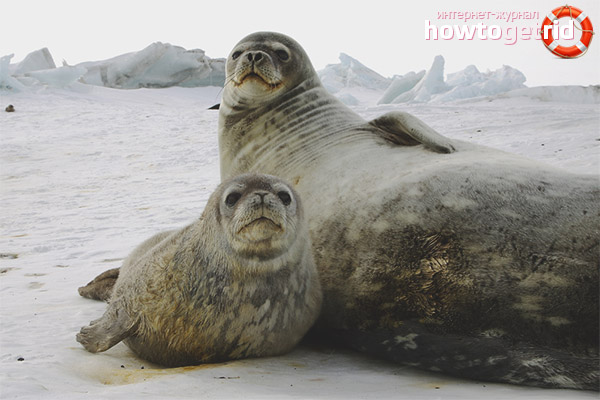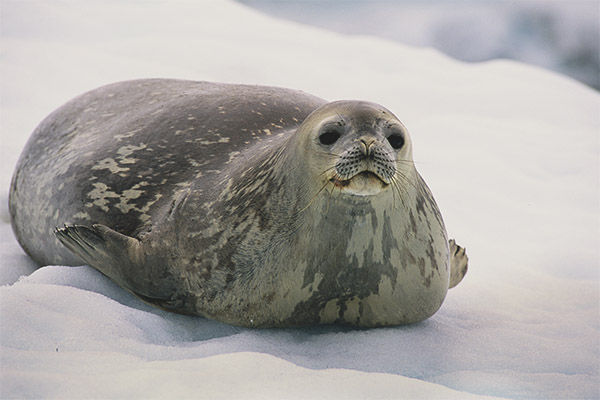The content of the article
Some animals got their name because of the people who discovered them. In particular, the Weddell Seal is named for Sir James Weddell. This man once went on a fishing expedition to the sea and found such seals in the Antarctic in substantial abundance.
Basic description
There are quite a few such seals on the territory of Antarctica, for the given period there are about 800 thousand people, they are among the most common. Outwardly, they resemble simple seals, and zoologists refer to the family with the characteristic name Real Seals, that is, they are practically a standard.
The body length of this animal is up to three meters, and the weight is up to 400 kilograms. As a rule, females are slightly larger, and these maximum parameters are indicated for them, and males often weigh about 30 kilograms less and 40 centimeters shorter in body.
The body is clad in a tough and short wool without undercoat, which most often has a brown-gray color. Sometimes completely black individuals are also observed, which have a slight shade of silver. It is also possible to see such Weddell seals that have oval spots of light color on the belly and sides.
In order to cope with the cold, these seals use thick fat, which is located under strong skin. A layer of fat is more than 10 centimeters and allows you to continuously stay in cold water.
Periodically, these seals molt, as a rule, between December and February, however, this fact has virtually no effect on behavior and habits, individuals do not feel discomfort from molting and continue to calmly swim in cold water.
Behavior and habitat space
These individuals live throughout the year off the Antarctic coast. They spend a lot of time on drifting ice, where they remain even with a significant cooling. As mentioned earlier, they have a rather impressive layer of fat, so no changes in the weather are significant for these animals.
When a severe winter comes, the Weddell seals descend into the water, where they spend most of their time. They approach the shore and swim there, only periodically emerging, in order to get a new portion of air.
This behavior is very reasonable, since the water temperature is kept slightly less than zero, and on land the temperature reaches -45, that is, much lower. If in such weather they go on ice, then a substantial layer of fat will not help either. Therefore, they make small holes in the ice and calmly float in warm water.
A question may arise here: how are such soft and tender seals making holes in such a hard and thick layer of Antarctic ice? To do this, they use their own teeth,which also keep the air holes in the right condition. Taking into account the temperature difference, it is easy to understand how quickly these holes can freeze, therefore, for prevention, the seals update each such air hole periodically, again swimming there and gnawing ice through their teeth.
Seals are excellent swimmers and can sink to significant depths. Quite normal for them is the depth of about 400 meters.
It is in the water surface and depths that the seals seek their own food, which are various cephalopods and fish. At the same time, they themselves have practically no natural enemies - and not surprisingly. Indeed, in such harsh conditions, few others can even exist at all, so Weddell seals, as a rule, live to old age, which becomes the cause of death.
Reproduction of Weddell Seals

There is a mating season that is rather short and falls in the fall from September to October. However, in Antarctica, this period is spring - young ice is being gathered, which is easy to gnaw through for blowouts, and it is also possible to gather on the shore in order toto organize colonies or to unite for this purpose on a large ice floe and swim along the coast.
One way or another, the spring collection of seals gathers about 50-100 individuals per group, but sometimes a colony can comprise up to 200 representatives. Thanks to such an association, partners can find each other and mate productively, after which a pregnancy occurs that lasts 10 months and ends with the birth of a small seal (usually one) up to 130 centimeters long and weighing up to 30 kilograms.
As a rule, the first 8 weeks the baby wears a long and thick fur, which has small dark spots, and generally grayish. After that, a more or less normal layer of fat is formed. By the way, feeding with milk also lasts about 8 weeks, and it is this that is the main factor that allows the baby to increase the fat required for Antarctic conditions.
After the little seal no longer needs breast milk and acquires a shaped body, it goes into the water and begins to act there independently, looking for food and doing other things. Upon reaching the age of three, females may give birth, puberty of males begins a little after and begins about 6 years after birth. Life expectancy is about 20 years.
Video: Weddell seal (Leptonychotes weddellii)











To send